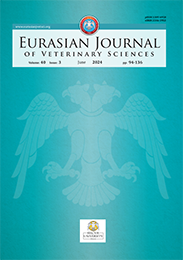| 2020, Cilt 36, Sayı 4, Sayfa(lar) 287-297 |
| [ Türkçe Özet ] [ PDF ] [ Benzer Makaleler ] |
| Determining the factors affecting cattle and small ruminant enterprises to get animal life insurance |
| Burak Mat1, Mustafa Bahadır Çevrimli1, Mustafa Agah Tekindal2, Aytekin Günlü1 |
| 1Selçuk Üniversitesi Veteriner Fakültesi Hayvan Sağlığı Ekonomisi ve İşletmeciliği Anabilim Dalı, Konya, Türkiye 2İzmir Kâtip Çelebi Üniversitesi, Tıp Fakültesi, Biyostatistik Anabilim Dalı İzmir, Türkiye |
| Keywords: Animal life insurance, risk management, cattle, small ruminant |
| Downloaded:855 - Viewed: 2423 |
|
Aim: This research is aimed to determine the reasons why producers have/do not
have animal life insurance (ALI), as well as to determine the factors that affect this
situation and to suggest solutions that will contribute to increasing the rate of insurance.
Materials and Methods: The material of the research was determined by the Agricultural Insurance Pool (TARSİM) as the enterprises engaged in small ruminant and cattle breeding in the provinces of Afyonkarahisar, Aksaray, Ankara, Burdur, Karaman and Konya. The minimum number of enterprises targeted to be visited and their distribution according to the provinces was calculated according to the Neyman stratified sampling method. Within the scope of the research, data collected from 252 enterprises were evaluated. In the analysis of the data, the relationship between the two variables was evaluated using the Pearson Correlation Coefficient and the Spearman Correlation Coefficient when it did not meet the prerequisites for parametric testing. Categorical data were analyzed by Fisher's Exact Test and Chi-Square test. In order to determine the reasons for not taking out insurance, the obtained data were evaluated by explanatory factor analysis method. Results: In terms of professional experience; Having less than 5 years of professional experience, having a certificate of disease freeness in enterprises, and have additional income sources other than animal husbandry the insurances rate of the enterprises are increasing. It can be said that the data of the relevant scale are suitable for factor analysis (p <0,05) and that the construct validity of the measuring tool is generally provided according to the factor analysis results. In the ALI Attitude Scale, which was developed as a result of factor analysis, the questions were distributed to 4 factors. The factors are respectively; Expectations from Insurance, Insurance Awareness, Procedure and Belief, Financial Factors, and Cost. Conclusion: The first condition for increasing the rate of having ALI is that producers should be constantly informed about ALI. It should be taken into consideration that some positive additional support and incentives, additional scoring, incentive payment priority, etc., may contribute positively to the system in producing policies and premiums. |
| [ Türkçe Özet ] [ PDF ] [ Benzer Makaleler ] |





